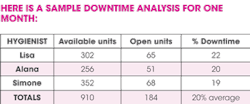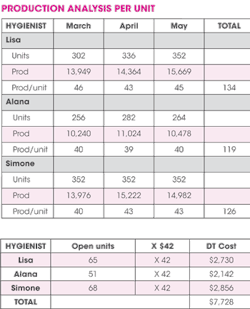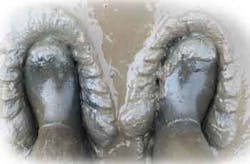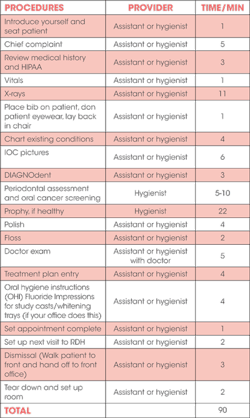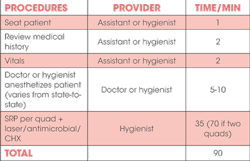Breakin' time down!
The anatomy of dental hygiene appointments often lead to wonderment about where the time went
By Lisa Dowst-Mayo, RDH, BSDH
We are going to break down some of the most common dental hygiene appointments and dissect their anatomy procedure by procedure. The best part about hygiene is the many styles of work one can do, while the hardest part is finding what works best for you and your practice. If you are feeling tired, overworked, frazzled, or want to pull your hair out at the end of the day, maybe the problem lies in the flow of your patient appointments.
The charts in this article present an easy-to-follow guideline of different hygiene appointments, which have been divided into five models:
As a dental hygiene educator, the most common question students ask me before they graduate is: "Mrs. Mayo, how in the world can I do all this in an hour?" My answer is, "You get an hour if you are lucky! Some offices see a hygiene patient every 40 to 50 minutes!"
----------------------------------------------
Other articles by Dowst-Mayo
----------------------------------------------
I do not say that to scare them; it's just a fact of life. In the city we live in, time is money, and time equals production dollars for employers. Throughout my career, I have listened to numerous "dental consultants" try to guide my dentists on how dental hygiene appointments should run. Actually, after 12 years of full-time private practice, I would venture to say that I have probably worked almost all hygiene schedules these consultants have created! I've worked the one-hour recare, the 90-minute new patient, the 50/45/40-minute recare appointments, and the 30-minute accelerated appointments. Ultimately, I truly believe each style has its own good points and drawbacks; and you have to discover for yourself what makes you comfortable and happy in the work you are doing day by day.
Through trial and error, I have learned one very important thing about dental hygiene schedules -- all the models work. However, they don't all work for me! I have found that that's the key to my "hygiene happiness," as I like to call it. If I don't like accelerated hygiene, but am forcing myself to do it four or five days a week, I'm not going to be happy with my career or my employer. It's not that accelerated hygiene does not work, or I feel rushed throughout the day, or my patient care decreases. It really boils down to the fact I just don't like it. I don't feel it utilizes my strengths as a provider and I don't get as much one-on-one time with my patients.
Other hygienists love this style of work because it fits their personalities nicely. Clinicians all have their own individual strengths they bring to the table. To be successful at any job, you need to be in a position that draws on your strengths and minimizes your weaknesses. For example, I am a very social person who likes to build personal relationships with my patients. I am also very comfortable discussing my doctor's treatment recommendations and have spent a lot of time and money on continuing education courses in cosmetic dentistry, Invisalign, implants, and advanced periodontal therapies that my practice utilizes. I feel very capable answering almost any patient questions regarding treatment, which is probably why I prefer unassisted hygiene appointments. As a new grad I did not feel this same way.
The charts below break down hygiene appointments by procedure. However, I recognize there are many variations that can exist. These templates are not my idea of how you should run your hygiene department; they present generalities to hygiene appointments, not absolutes. There are no absolutes when it comes to health care. Everything on this list should be left up to interpretation by the providers. Each individual office should run their hygiene departments in a manner that fits best with their patients' needs and their style of dentistry.
There are two major factors that will change the time allotted for each procedure and the overall time needed per patient on a hygiene schedule:
1. Individual patient needs. Not every patient fits into a perfect mold or into a perfect day of scheduling, as I'm sure we have all experienced. If your practice sees patients with special needs, patients with multiple systemic diseases or conditions, heavy patient loads of moderate to advanced periodontal disease, or predominately pediatric patients, these templates may not be the ideal fit for you.
2. Hygienists' speed. With experience and time, all hygienists' speed will increase. The longer you have been practicing in a specific office, the faster you will be able to perform tasks, as you gain knowledge and comfort with your surroundings. If the computer software an office uses is new to you, it will slow you down until you become proficient in it. I know I was much slower as a new graduate in all procedures than I am now. Again, with practice and dedication to your craft, your speed will increase without you having to sacrifice quality of care.
Lisa Dowst-Mayo graduated magna cum laude from the Caruth School of Dental Hygiene at Baylor College of Dentistry in 2002, with a bachelor's degree in dental hygiene. She has held numerous leadership roles in the tripartite of the American/Texas/Dallas Dental Hygiene Associations. She is an author, clinician, educator, and enthusiastic public speaker. Lisa is a dental hygiene instructor at Concorde Career College in San Antonio and also works part-time as a private practice clinician at Dominion Dental Spa. She has published numerous articles on a broad range of topics for both RDH and Access Magazine and has written CE courses for PennWell. She is a cofounder of the company Diamond Dental Education, which provides CE courses for dental professionals in Texas. She can be contacted through her website www.lisamayordh.com.
References
1. AAP. "Parameter on Periodontal Maintenance." J Periodontol. 2000;71:849-850.
2. AAP. "Parameter on Comprehensive Periodontal Examination." J Periodontol. 2000;71:847-848.
3. Calley K, Hodges K. "Automate Your Probing Process." Dimension of Dental Hygiene. Feb 2011;73:2686-2688.
4. Cleveland J, Junger M, Saraiya M, Markowitz L, Dunne E, Epstein J. The connection between human papillomavirus and oropharyngeal squamous cell carcinomas in the United States. Implications for Dentistry. JADA. August 2011;142(8):915-924.
5. Darby M, Walsh M. "Dental Hygiene: Theory and Practice." 3rd ed. St. Louis, MO: Saunders Elsevier, 2010.
6. Huff K, Stark P, Solomon S. "Sensitivity of Direct Tissue Fluorescence Visualization in Screening for Oral Premalignant Lesions in the General Practice." Gen Dent. Mar-Apr 2010;58(2):126-9.
7. Messadi D. "Diagnostic Aids for Detection of Oral Precancerous Lesions." Int. J. Oral Sci. June 2013;5(2):59-65.
8. Wilkins E. "Clinical Practice of the Dental Hygienist." 11th ed. Philadelphia, PA: Lippincott, Williams and Wilkins, 2013.
MODEL 1: 60-minute unassigned hygiene appointments
For offices that use 40/45/50-minute unassisted hygiene appointments, you would use this model, but you'd have to speed everything up. The hygienist will have to find ways to cut down the 60-minute appointment into 40, 45, or 50 minutes somehow. That means you either work faster, try to find ways to speed up procedures, or have an assistant available to help you throughout the day. It would not be suggested to cut things out of a hygiene appointment to help cut the time down, as all the procedures below are needed in an appropriate dental hygiene appointment.
MODEL 3: 60-minute accelerated/assisted hygiene
Patients are usually stagger-booked with this model, meaning all appointments overlap by 30 minutes. So, for a nine-hour day (with a one-hour lunch), the hygienist or hygiene assistant will see 16 patients. The hygienist and hygiene assistant work out of two rooms and see patients simultaneously. Offices utilize their hygienist and assistant differently in this model, as indicated below. I have personally worked this schedule in two different offices. In one office, I was responsible only for probing, oral cancer screening, prophies, and polishing, while the hygiene assistant performed all other procedures. The other office split the responsibilities of a hygiene appointment more evenly between the hygiene assistant and me. I did the medical history review, vitals, probe, oral cancer screening, prophy, polish, floss, and doctor exam, and the assistant sat the patient, obtained the chief complaint, did treatment plan entry, gave oral hygiene instructions, set up the next recare visit, walked patient to the front for dismissal, and flipped the room.
MODEL 4: 90-minute assisted or accelerated new patient
Again, with this model, patients are stagger-booked. The hygienist and hygiene assistant work out of two rooms with patients being seen simultaneously. Some offices use this model with new patient appointments and cut down the time to 60 minutes. When I worked a 60-minute assisted new patient appointment at one temping job, the office did not utilize intraoral camera pictures, DIAGNOdent, or any oral hygiene instruction that could be worked into a conversation while doing the prophy. There were no models for patient education and the doctor's exam took less than one or two minutes. There was very little interaction between providers and patients in the back. This is how they were able to cut the time from 90 minutes to 60 minutes. I'm not saying this is good or bad; it was just that office's style of doing dentistry.
MODEL 5: Scaling and root planing
SRP procedures will vary dramatically from one patient to the other. The below speed is based on that "perfect" SRP patient. The patient that gets numb easily, has low anxiety, the subgingival calculus is removed with little effort, and whose periodontal destruction is not beyond an early to moderate stage. Not every patient fits this mold. For that matter, not every hygienist's speed fits this mold either. Perio treatments are hard to template – actually, almost impossible to template. Many offices utilize block scheduling, which I think is great. However, almost all hygienists can attest to the fact that it is difficult to guess the exact amount of time it will take to complete a quadrant of scaling on each and every patient. Treatment varies so dramatically in this category, but the below chart is a good starting point and a good goal to have so daily production numbers add up nicely at the end of the day.


